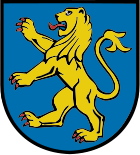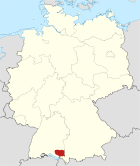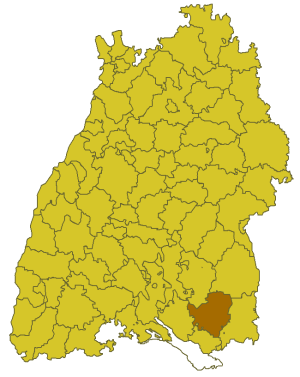Ravensburg district
| coat of arms | Germany map |
|---|---|

|

Coordinates: 47 ° 47 ' N , 9 ° 37' E |
| Basic data | |
| State : | Baden-Württemberg |
| Administrative region : | Tübingen |
| Region : | Lake Constance Upper Swabia |
| Administrative headquarters : | Ravensburg |
| Area : | 1,631.86 km 2 |
| Residents: | 284,285 (Dec. 31, 2018) |
| Population density : | 174 inhabitants per km 2 |
| License plate : | RV, SLG , ÜB , WG |
| Circle key : | 08 4 36 |
| NUTS : | DE148 |
| Circle structure: | 39 municipalities |
| Address of the district administration: |
Friedenstrasse 6 88212 Ravensburg |
| Website : | |
| District Administrator : | Harald Sievers ( CDU ) |
| Location of the district of Ravensburg in Baden-Württemberg | |
The district of Ravensburg is a district in Baden-Württemberg . In terms of its area, it is the second largest district in the state after the Ortenaukreis and, together with the Bodenseekreis and the Sigmaringen district, forms the Bodensee-Oberschwaben region in the Tübingen administrative district .
geography
location
The district of Ravensburg has a share in the Upper Swabian hill country , which extends from it further north ( Biberach ) and south ( Friedrichshafen ). It includes parts of the West Allgäu hill country in the east and the Linzgau in the west . 60.2 percent of the total area is used as agricultural land. In the district, the border of the Allgäu, more precisely the Westallgäu, runs from Scheidegg in Bavaria via Wangen, Leutkirch to Legau in Bavaria .
places
There are around 2365 localities in the Ravensburg district .
Neighboring areas
The district of Ravensburg borders clockwise in the north, beginning with the district of Biberach (in Baden-Württemberg), the district of Unterallgäu , the independent city of Memmingen and the districts of Oberallgäu and Lindau (Lake Constance) (all in Bavaria ) as well as the district of Lake Constance and to the district of Sigmaringen (both in turn in Baden-Württemberg).
Division of space

According to data from the State Statistical Office , as of 2015.
history
The district of Ravensburg goes back to the Württemberg Oberamt Ravensburg , which was established after the transition of the formerly free imperial city of Ravensburg and its surrounding area to the Kingdom of Württemberg in 1810. As early as 1806, the Altdorf, Isny and Waldsee offices were established. From 1810 onwards, in addition to Ravensburg, the regional offices of Leutkirch , Saulgau , Tettnang , Waldsee and Wangen also had a share in what is now the district . From 1810 the upper offices belonged to the Landvogtei on Lake Constance and from 1818 to the Danube District . The boundaries of the upper offices were changed slightly in 1842. In 1924 the Danube District was dissolved and in 1934 the upper offices were renamed to districts. In 1938 the Leutkirch and Waldsee districts were dissolved, with the majority of the Waldsee district coming to the Ravensburg district (the rest to the Biberach district ) and the majority of the Leutkirch district to the Wangen district .
During the district reform , the Ravensburg district was merged with the Wangen district on January 1, 1973. In addition, some communities in the Saulgau district and the Unterschwarzach community in the Biberach district were joined to the new Ravensburg district.
On May 1, 1973 the districts of Höhreute, Niederweiler and Tafern of the municipality of Illmensee belonging to the district of Sigmaringen were reclassified to the municipality of Wilhelmsdorf .
On January 1, 1976, the places Gensenweiler, Hagnaufurt, Hervetsweiler and Wattenweiler were separated from the city of Bad Waldsee and incorporated into the municipality of Ingoldingen in the Biberach district.
After the municipal reform has been completed, the district of Ravensburg still comprises 39 municipalities, including eight cities and of these four large district towns ( Leutkirch im Allgäu , Ravensburg , Wangen im Allgäu and Weingarten ). The largest city in the district is Ravensburg, the smallest municipality is Guggenhausen .
Population development
The population figures are census results (¹) or official updates from the Baden-Württemberg State Statistical Office ( main residences only ).
|
|
politics
The district is administered by the district council and the district administrator.
District council
The district council is elected for five years by those entitled to vote in the district. The election on May 26, 2019 led to the results shown in the diagrams.
- Results of the district elections since 1989
| Parties and constituencies | % 2019 |
Seats 2019 |
% 2014 |
Seats 2014 |
% 2009 |
Seats 2009 |
% 2004 |
Seats 2004 |
% 1999 |
Seats 1999 |
% 1994 |
Seats 1994 |
% 1989 |
Seats 1989 |
|
|---|---|---|---|---|---|---|---|---|---|---|---|---|---|---|---|
| CDU | Christian Democratic Union of Germany | 33.47 | 24 | 41.08 | 30th | 41.13 | 31 | 44.8 | 34 | 48.9 | 38 | 44.1 | 39 | 50.4 | 40 |
| FW | Free electoral association | 21.87 | 17th | 19.76 | 15th | 23.09 | 18th | - | - | - | - | - | - | - | - |
| Flat share | Electoral associations | - | - | - | - | - | - | 23.4 | 19th | 21.6 | 16 | 19.4 | 15th | 16.7 | 13 |
| GREEN | Alliance 90 / The Greens | 21.93 | 15th | 16.07 | 11 | 13.56 | 9 | 12.1 | 7th | 9.3 | 6th | 9.5 | 7th | 7.6 | 5 |
| SPD | Social Democratic Party of Germany | 8.17 | 6th | 10.61 | 7th | 9.26 | 6th | 11.4 | 7th | 13.0 | 8th | 16.2 | 11 | 15.7 | 10 |
| ÖDP | Ecologically Democratic Party | 7.53 | 5 | 6.72 | 5 | 6.37 | 4th | - | - | - | - | - | - | - | - |
| FDP | Free Democratic Party | 5.48 | 4th | 3.43 | 2 | 4.78 | 3 | 2.1 | 1 | 0.7 | - | 1.8 | 1 | 2.3 | 1 |
| LEFT | The left | 1.44 | 1 | 2.33 | 2 | 1.80 | 1 | - | - | - | - | - | - | - | - |
| Otherwise. | Others | 0.1 | - | - | - | - | - | 6.2 | 4th | 6.4 | 4th | 8.9 | 6th | 7.4 | 5 |
| total | 100 | 72 | 100 | 72 | 100 | 72 | 100 | 72 | 100 | 72 | 100 | 79 | 100 | 74 | |
| voter turnout | 59.66% | 49.86% | 51.8% | 52.6% | 53.1% | 66.4% | 59.8% | ||||||||
- WG: Voter associations, as the results from 1989 to 2004 cannot be broken down into individual groups of voters and small parties.
District Administrator
The district council elects the district administrator for a term of eight years. He is the legal representative and representative of the district as well as chairman of the district council and its committees, but has no voting rights in the committees . He heads the district office and is an official of the district.
His area of responsibility includes the preparation of the district council meetings and its committees. He calls meetings, chairs them and implements the resolutions passed there. His deputy is the first state official.
The district councils of the district Ravensburg since 1937:
- 1937–1945: Theodor Kreeb
- 1945–1947: Hermann Bendel (provisional)
- 1947–1978: Oskar Sailer
- 1978-1999: Guntram Blaser
- 1999–2015: Kurt Widmaier
- since 2015: Harald Sievers
The Oberamtmen of the former Oberamt Ravensburg from 1810 to 1936 are shown in the article Oberamt Ravensburg .
The district administrators of the former district of Wangen from 1938 to 1972 are shown in the article, district of Wangen .
coat of arms
The coat of arms of the district of Ravensburg shows a red-tongued and red-armored golden lion in blue. The coat of arms was newly awarded on November 6, 1952 and after the district reform on January 20, 1975.
The coat of arms represents the Guelph lion. The Guelphs had their Upper Swabian center in Ravensburg and Altdorf (today Weingarten) before the area came to the Hohenstaufen .
flag
The flag of the district of Ravensburg is - according to the coat of arms - yellow-blue.
District finances
The Ravensburg district (with its own operations) was indebted to the amount of EUR 67,372,756 as of December 31, 2015.
The most important key figures of the district budget (as of December 31, 2014):
- Ordinary income: 341,181,889 euros
- Ordinary expenses: EUR -313,761,798
- Decent result: 27,420,091 euros
- Investment volume: −29,895,642 euros
- Balance sheet total: 311,516,051 euros
- Real assets: 174,237,479 euros
- Financial assets: 145,335,698 euros
Economy and Infrastructure
In the Future Atlas 2016, the Ravensburg district was ranked 110th out of 402 districts, municipal associations and independent cities in Germany, making it one of the regions with “future opportunities”.
The economic development of the district of Ravensburg is carried out by WIR GmbH, Economic Development and Innovation Promotion Agency of the district of Ravensburg .
traffic
The federal motorway 96 Lindau - Munich runs through the eastern district area . In addition, it is accessed by federal, state and district roads. The most important federal highways are the B 30 Ulm - Friedrichshafen and the B 32 Sigmaringen - Ravensburg - Wangen .
The Württembergische Südbahn ( Ulm - Friedrichshafen ) also crosses the district and thus connects it to the national rail network. The district holds 17.5% of the capital in Bodensee-Oberschwaben-Bahn GmbH & Co. KG , which operates local transport on the Südbahn. The eastern part of the district is opened up by the Württembergische Allgäubahn .
District facilities
The Ravensburg district is responsible for several vocational schools and two special needs education and advice centers :
- Aulendorf: Location of the Edith-Stein-Schule Ravensburg and Aulendorf (house and agricultural, industrial and commercial school) Former vocational school Aulendorf with a social and health science high school Profiles Social and Health (SG and GG)
- Bad Waldsee: nursing school
- Kißlegg: Albert Schweitzer School (special educational and advisory center with a focus on intellectual development)
- Leutkirch: Commercial school with technical high school (TG)
- Leutkirch: Sophie Scholl School for Housekeeping, Agriculture, Environment, Social Pedagogy and Nursing with a Social and Health Science Gymnasium Profile Social (SG)
- Ravensburg: Location of the Edith Stein School Ravensburg and Aulendorf (home and agricultural, industrial and commercial school) with agricultural science (AG), biotechnology (BTG), nutrition (EG) and social and health science high school profile social (SG)
- Ravensburg: Technical college for agriculture (with housekeeping department in Bad Waldsee)
- Ravensburg: Commercial schools
- Ravensburg: Humpis School (commercial school)
- Ravensburg: Martinus School with school kindergarten (special education and advice center with a focus on intellectual development)
- Wangen: Friedrich-Schiedel-Schule (vocational school and state vocational school for dairy trades)
- Wangen: Commercial school (with branch in Isny)
- Cheeks: Nursing School
Together with the city of Ravensburg, the district of Ravensburg is a partner in Oberschwaben Klinik gGmbH, which was founded in 1997. The society is responsible for the former district hospitals of Wangen im Allgäu (today "Klinikum Westallgäu") and Bad Waldsee, as well as the St. Elisabeth Hospital in Ravensburg with the St. Nikolaus Department for Child and Adolescent Medicine and the Ravensburg Hospital of the Holy Spirit.
Communities
(Residents on December 31, 2018)
The old district of Ravensburg
Before the district reform on January 1, 1973 and the community reform , the (old) district of Ravensburg had a total of 37 communities since 1938 , including four towns . From April 1, 1939 to April 1, 1946, the city of Weingarten was part of the city of Ravensburg.
On March 7, 1968, the state parliament of Baden-Württemberg set the course for a community reform . With the law to strengthen the administrative power of smaller municipalities , it was possible for smaller municipalities to voluntarily unite to form larger municipalities. The beginning in the old district of Ravensburg was made on July 1, 1971 by the community of Gaisbeuren, which was incorporated into the town of Bad Waldsee . In the period that followed, the number of communities steadily decreased.
The remaining communities of the (old) district of Ravensburg went on January 1st, 1973 in the new, enlarged district of Ravensburg.
The largest municipality in the old Ravensburg district was the district town of Ravensburg , which has been a major district town since April 1, 1956 . The smallest congregation was the pledges.
The old district of Ravensburg last covered an area of 714 km² and had a total of 121,034 inhabitants at the 1970 census .
The table shows the population development in the old Ravensburg district up to 1970. All population figures are census results.
|
|
In the table, the municipalities of the old district of Ravensburg are before the municipal reform. All communities still belong to the Ravensburg district today.
License Plate
On July 1, 1956, the district was assigned the distinctive sign RV when the vehicle license plates were introduced . It is still issued today.
Until the 1990s, vehicles from the old district of Wangen received license plates with the letter pairs AA to EZ and the numbers from 100 to 999.
On November 19, 2019, the district council decided to reintroduce the old license plates WG (Wangen im Allgäu), ÜB (Überlingen) and SLG (Bad Saulgau).
From July 22, 2020, the earlier distinguishing signs ÜB (Überlingen), SLG (Saulgau) and WG (Wangen) will be issued again in the Ravensburg district.
Individual evidence
- ↑ a b Statistisches Landesamt Baden-Württemberg - Population by nationality and gender on December 31, 2018 (CSV file) ( help on this ).
- ↑ Source: Statistics for the EUREGIO Lake Constance. In: Listed! The ten districts of the Lake Constance region… In: Südkurier from February 25, 2011 and in: Ders. dated July 2, 2011
- ↑ Survey of land according to type of actual use in 2015
- ↑ a b Federal Statistical Office (ed.): Historical municipality register for the Federal Republic of Germany. Name, border and key number changes in municipalities, counties and administrative districts from May 27, 1970 to December 31, 1982 . W. Kohlhammer, Stuttgart / Mainz 1983, ISBN 3-17-003263-1 , p. 531 and 547 f .
- ↑ http://wahlen11.rz-kiru.de/08436000W/kw2019.html
- ↑ [1] Result of the district council election 2019
- ↑ [2] Result of the district election 2014
- ↑ [3] ( page no longer available , search in web archives ) Info: The link was automatically marked as defective. Please check the link according to the instructions and then remove this notice. Distribution of votes in the district elections 1989–2009
- ↑ [4] ( Page no longer available , search in web archives ) Info: The link was automatically marked as defective. Please check the link according to the instructions and then remove this notice. Distribution of seats in district elections 1989–2009
- ↑ District Office Ravensburg, 2015 budget
- ↑ Future Atlas 2016. Archived from the original on October 2, 2017 ; accessed on March 23, 2018 . Info: The archive link was inserted automatically and has not yet been checked. Please check the original and archive link according to the instructions and then remove this notice.
- ↑ a b Edith Stein School | Edith Stein School Ravensburg & Aulendorf. Retrieved May 10, 2017 .
- ↑ [ [5] Reintroduction of the old labels SLG, ÜB and WG shifted] . rv.de. April 27, 2020. Accessed May 9, 2020.
literature
- Ravensburg district. (= The city and rural districts of Baden-Württemberg in words and numbers; Issue 39) . Published by the Ministry of the Interior and Ministry of Economics in Baden-Württemberg, processing and printing of the State Statistical Office of Baden-Württemberg, Stuttgart, 1967.
- Chronicle of the Ravensburg district. Landscape, history, customs, art . Chroniken-Verlag Boxberg, Hinterzarten 1975
- Oskar Sailer (ed.): The district of Ravensburg . Theiss, Stuttgart 1976, ISBN 3-8062-0145-5
- Landesarchivdirektion Baden-Württemberg (Ed.): The state of Baden-Württemberg. Official description by district and municipality. Volume 7: Tübingen administrative region. Kohlhammer, Stuttgart 1978, ISBN 3-17-004807-4 .
- Wolfram Angerbauer (Red.): The heads of the upper offices, district offices and district offices in Baden-Württemberg from 1810 to 1972 . Published by the working group of the district archives at the Baden-Württemberg district assembly. Theiss, Stuttgart 1996, ISBN 3-8062-1213-9 .
- Hans Ulrich Rudolf (Hrsg.): The district of Ravensburg in the mirror of the literature. A district bibliography . OVA, Ravensburg 1999, ISBN 3-926891-22-X
- District of Ravensburg (Ed.): In the Oberland. Culture, history, nature. Contributions from Upper Swabia and the Allgäu ; appears every six months , ISSN 0939-8864 (since 2016 title only Oberland )
Web links
- Official website of the district
- Statistics platform Lake Constance
- About inventors, heretics and shield citizens - cities between Lake Constance and Upper Swabia
- Description of the Oberamt Ravensburg from 1836 at Wikisource
- Description of the Oberamt Waldsee from 1834 at Wikimedia Commons
- Description of the Oberamt Wangen from 1841 at Wikisource
- Literature on the district of Ravensburg in the catalog of the German National Library






